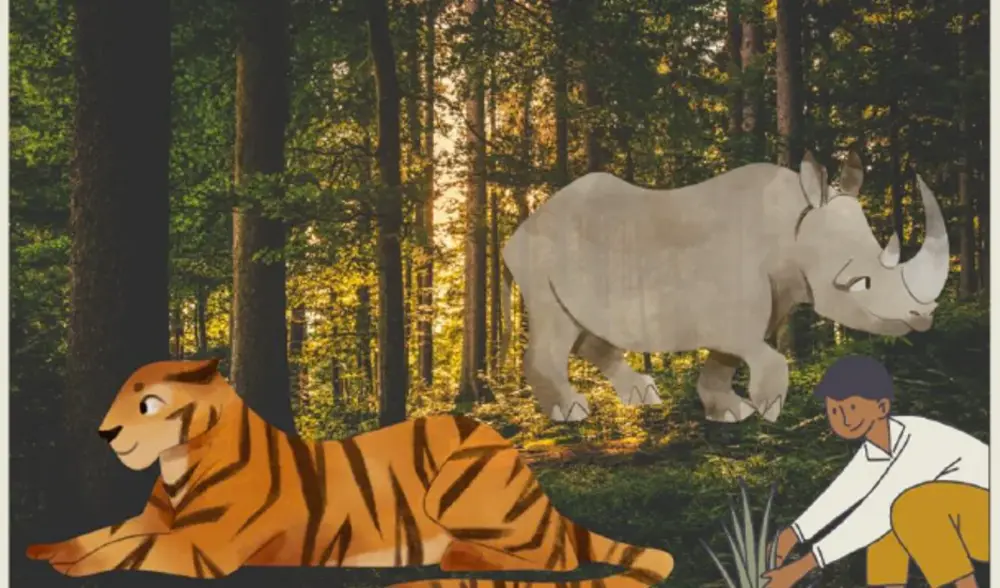Reimagining relationship between National Parks and Indigenous People - A Case of Nepal

Indigenous communities play a significant role in nature conservation. There are increasing evidence such as the 2019 Intergovernmental Science-Policy Platform on Biodiversity’s (IPBES) media report which states that the land and marine environment has been significantly degraded by human actions. However, it was less severe on average in areas managed by indigenous people. This highlights the need of collaboration with indigenous communities.
In case of Nepal, the conservation efforts formally began after the enactment of National Parks and Wildlife Conservation Act (NPWC Act) 1974. At present, the protected areas covers 23.39% of the country as reported by the Department of National Parks and Wildlife Conservation. Nepal has been showing promising results in the field of wildlife and nature conservation. Endangered species such as the tiger and rhino have largely benefitted, as reported by the recent National Tiger Survey (2021-22) and organizations such as The World Wildlife Fund for Nature (WWF).
However, in the process of establishing protected areas, indigenous communities were forcibly relocated from their land (Amnesty International, 2021). Their access to natural resources was totally or partially curtailed for the establishment of protected areas. This affected their spiritual, economic and cultural ties with nature. The conservation strategy eventually met with criticism and opposition for being heavily influenced by the western ideals of undisturbed nature and not recognizing the environmental stewardship of indigenous communities since generations (Dowie, 2011). Then, efforts were made in mid 90s to make conservation approaches more community and people oriented. The NPWC Act, main law to govern protected areas, was amended to introduce conservation areas and buffer zones which allowed for collaboration between government, NGOs, local people and conservation authorities (Thakali et al., 2018). On the international level as well, Nepal committed to recognizing the rights of indigenous communities by becoming a member of various international commitments such as ILO 169, UNDRIP, CED and adopted SDGs.
Despite amendments, the government still does not require consent of indigenous people to declare any area as a national park, which is a core problem of the NPWC Act. Another crucial problem is the poor implementation of some progressive provisions in NPWC Act such as the allowance of indigenous people in buffer zones to pursue traditional occupations (Amnesty International, 2021). A major national daily in Nepal revealed that Sonaha, an indigenous community were able to get licenses for traditional fishing in Bardia National Park only two decades after the park’s establishment. This achievement was momentary as licenses for the whole community were cancelled after two Sonaha men were arrested on the suspicion of involvement in rhino poaching. This is an example of a reluctance to implement existing provisions.
For the conservation efforts to be sustainable, the government needs to resolve hardships faced by indigenous communities and forge meaningful alliances with them. By including indigenous communities in planning and development, and ensuring access to forest resources for traditional occupations, the Nepal government could take one step ahead to reduce those hardships and rebuild a relationship of trust and support with the communities. The following policy recommendations will be important for the Nepal government so that it can build on existing efforts to include indigenous people in nature conservation:
Policy Recommendation 1: Amend the NPWC Act to ensure free and prior informed consent of indigenous communities:
The Section 3.1 of NPWC Act should be amended to ensure the rights of indigenous people for a free and prior informed consent of indigenous communities to declare an area a national park (Amnesty International, 2021). As per the Constitution of Nepal, national parks are under the federal powers and the federal level Ministry of Forests and Environment is responsible for the amendment of NPWC Act. In cases where there is no possible way than to displace indigenous communities, the Act must be revised to add a provision that allow affected people to get compensated fairly (Amnesty International, 2021).
Policy Recommendation 2: Ensure national laws are implemented smoothly and in line with international commitments:
It is important to ensure smooth implementation of already existing measures for which the Department of National parks and Wildlife Conservation is responsible. For instance: Amendment in Section 5.2 of NPWC Act states that local people in buffer zones are allowed to carry out their traditional occupations of fishing, harvesting but local people are still not provided permits.
Nepal is a part to ILO Convention 169, Convention on Biological Diversity, UNDRIP and SDGs. The federal ministry needs to abide by these international commitments and facilitate effective consultations with indigenous peoples in matters concerning the conservation of protected areas on their ancestral lands. It should ensure the SDGs vision of leaving no one behind is fulfilled. There is also a need to tackle growing conflict between SDG 1 (poverty reduction) and SDG 15 (sustainable forest management, restoring natural habitat).
References:
Amnesty International. (2021). Violations in the Name of Conservation. Retrieved from: https://www.amnesty.org/en/wp-content/uploads/2021/08/ASA3145362021ENGLISH.pdf
Dowie, Mark. (2011). Conservation Refugees: The Hundred-Year Conflict between Global Conservation and Native Peoples. Cambrige & London: The MIT Press.
Gurung, P. D. (2020). “Mountains are commons, grasses are divided”: Indigenous environmental governance between conservation and democracy. Retrieved from https://www.proquest.com/dissertations-theses/mountains-are-commons-grasses-divided-indigenous/docview/2447263803/se-2
Intergovernmental Science-Policy Platform on Biodiversity and Ecosystem Services (IPBES). (2019). Media Release: Nature’s Dangerous Decline ‘Unprecedented’; Species Extinction Rates ‘Accelerating’. Retrieved from: ipbes.net/news/Media-Release-Global-Assessment
Thakali, S., Peniston, B., Basnet, G., & Shrestha, M. (2018). Conservation and Prosperity in New Federal Nepal: Opportunities and Challenges. The Asia Foundation. Retrieved from: https://asiafoundation.org/publication/conservation-and-prosperity-in-new-federal-nepal-opportunities-and-challenges/
Cover photo courtesy of Canva

About the author
Smriti Rai is a first-year MPP student at the Willy Brandt School of Public Policy, specializing in socio-economic and development policies.
~ The views represented in this blog post do not necessarily represent those of the Brandt School. ~